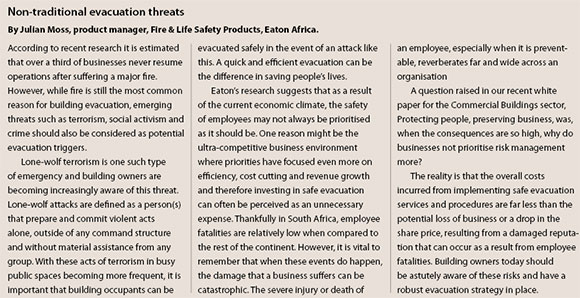
The business and commercial property landscape is changing as a result of mass urbanisation and population growth, in fact 64,3% of the current South Africa population lives in urban areas. As a result, buildings are now being constructed taller than ever before so they remain within the constraints of land use designation.
South Africa is one of the most structurally and economically developed nations on the African continent. As such, its major cities have experienced construction booms that most other cities of similar size in Africa have not. In South Africa, there are approximately 49 buildings over 100 metres high, with the majority in Cape Town, Port Elizabeth, Durban, Pretoria and Johannesburg.
Tall buildings bring about massive evacuation challenges for businesses. Safely evacuating a sky scraper with 25 floors and over 3000 occupants is an incredibly complex process. When a building is multiple stories high, the stairs act as major constriction points causing congestion on the escape routes and the risk of people stumbling on stairs is considerably higher than on a level escape route.
Another trend that is having a significant impact on the process of evacuation is that new, large commercial buildings are less like traditional office space and more like multi-functional hotels that offer employees a high level of service and comfort. Multi-functional buildings that include residential and commercial premises, as well as restaurants and shops are far more vulnerable to hazards (such as fire) that could lead to a mass evacuation.
Another emerging practice is flexible working hours, which could have a positive impact on the economy but could also present a challenge for safe evacuation processes. Flexible working means that employees’ whereabouts are more uncertain, which in turn, makes executing safe evacuation difficult. In many companies, the sign in/sign out system has become inadequate, and offices that offer an array of services (such as swimming pools, gyms and relaxation areas) make monitoring employees’ location even more difficult.
With these trends in mind, the task of protecting people and property in emergency situations requires careful attention and appropriate investment. Eaton’s recent white paper entitled Protecting People, Preserving Business, identifies the following three steps to protect your building occupants:
1. Identify the specific risks to consider in your building.
2. Select and design systems and solutions addressing the specific risks identified.
3. Conduct regular testing and maintenance of solutions.

For more information, visit www.eaton.com
© Technews Publishing (Pty) Ltd. | All Rights Reserved.